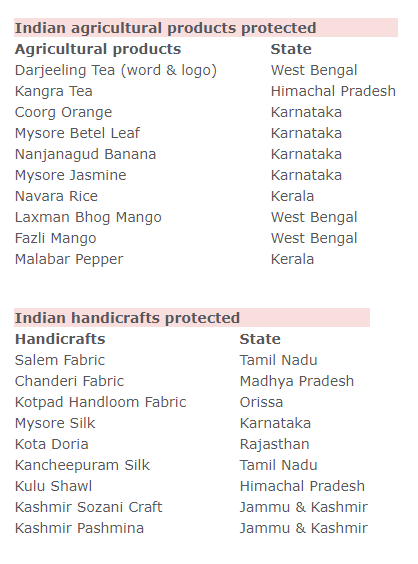A guide to protecting geographical indications in India Geographical Indications (GI) constitute an important category of intellectual property (IP) law and are of particular significance to some countries. Most commonly, a GI includes the name of the place of origin of the goods e.g. Ceylon tea (from Sri Lanka), Champagne (sparkling wine for France), Havana cigars (tobacco from Havana), Bukhara (carpets from Uzbekistan). The protection takes the form of joint exclusive rights allocated to a group of producers within the relevant geographical area in order to protect their interests and combat unfair competition. The statutory protection helps to enhance the value of the product as well as minimize the chances of consumer deception in terms of quality of a product.
The Geographical Indications Act of India, 1999
The objective of the GI Act of India (the Act) is to provide:
- better legal protection in respect of GIs
- to prevent unauthorized persons from misusing GIs
- to protect consumers from deception
- to promote goods bearing Indian GIs in the export market.
A GI is defined under the Act as "an indication in relation to goods which identifies such goods as agricultural goods, natural or manufactured goods as originating or manufactured in the territory of a country or a region or locality in that territory, where a given quality, reputation or other characteristic of such goods is essentially attributable to its geographical origin and in case where such goods are manufactured goods one of the activities of either the production or of processing or preparation of the goods concerned takes place in such territory, region or locality, as the case may be".
Broadly, the GIs as defined in the Act cover not only agricultural and natural goods originating out of a specific geographical location, but also extend to manufactured goods. The GIs are of particular significance to India which is essentially an agriculture-based economy. Also, India's handicraft sector is one of the largest foreign exchange earners for the country. With around 23 million people involved in the making of handicrafts it is the second largest employment sector in India, next only to agriculture.
Overall, with around 80 different languages spoken in 28 states of India, the nation's cultural diversity brings a potpourri of handicrafts, food and fabrics which are unique due to their special characteristics, qualities, methods, and the human skills required to make that product unique and exclusive.
Broadly, the GIs on the Indian GI Register can be classified as:
Agricultural products
The distinctive character could be due to the type of soil, amount of sunshine, the exact climatic conditions, water and traditional methods of plantation, all of which contribute to the distinctive characteristics, special taste and aroma of the product e.g. Darjeeling tea, Basmati rice and Alphonso mango.

Although handicrafts can be protected under the Copyright or Designs Act, most of the Indian traditional handicrafts such as Pashmina and Kancheepuram silk etc, are produced by artisans who belong to a particular geographical location where either the special raw material is found and/or human skills were developed that make the handicraft special and unique. Therefore, the exclusive rights arising out of such products belong to the group of artisans and not a single individual or organization. The protection of such group rights in the form of a GI is justifiable.
Overall, since the time the Act was passed in 2003, around 178 indications have been registered with the GI Registry in Chennai and the number is growing. The enactment of the Act has helped to provide incentive to the artisans/producers who can now claim exclusive rights in their products and subsequently grow economic prosperity and promote rural entrepreneurship.
Foreign applicants
The majority of applications and registrations for GIs currently on the Indian GI Register belong to Indian entities. However, recently a number of foreign applicants have successfully obtained GI protection in India which is encouraging for right owners. PISCO was the first foreign GI application filed in India under Section 84 of the Act that allows goods of foreign origin which have built up sufficient reputation in India to seek registration. PISCO is an indigenous brandy which is prepared from 'Pisquera grapes' by applying traditional production and distillation techniques that are specific to its place and country of origin.
